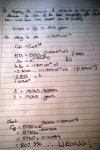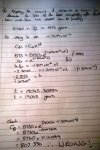Radiocarbon dating can be used to estimate the age of material that comes from a formerly living organism, such as an animal or a plant. When the organism dies, the amount of carbon-14 in its remains decays exponentially. Suppose that C(t) is the amount of carbon-14 in an organism at time t (in years), where t = 0 corresponds to the time of the death of the organism. Assume that the amount of carbon-14 is modelledby the exponential decay function C(t) = C0ekt (t ≥ 0), where C0 is the initial amount of carbon-14 and k is a constant.
The half-life (or halving period) of a radioactive substance like carbon-14 is the time that it takes for the amount of the substance to decrease to half of its original level.
(a) Given that the half-life of carbon-14 is 5730 years, find the value of the constant k, correct to three significant figures. [3]
(b) Suppose that some organic remains have been found where the amount of carbon-14 is known to have decreased to 1/10 of the level that was present immediately after the death of the organism. How much time has elapsed since the death of this organism? Give your answer to the nearest whole number of years.
The half-life (or halving period) of a radioactive substance like carbon-14 is the time that it takes for the amount of the substance to decrease to half of its original level.
(a) Given that the half-life of carbon-14 is 5730 years, find the value of the constant k, correct to three significant figures. [3]
(b) Suppose that some organic remains have been found where the amount of carbon-14 is known to have decreased to 1/10 of the level that was present immediately after the death of the organism. How much time has elapsed since the death of this organism? Give your answer to the nearest whole number of years.
Last edited by a moderator:


